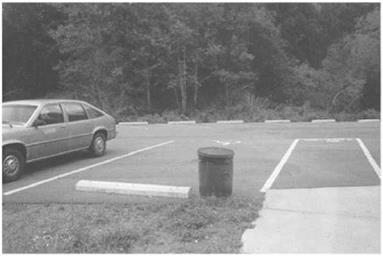The layout of the parking area, bay markings and location of facilities should take account of the needs of visitors with disabilities. Usually a number of bays should be reserved for their use, located as near as possible to the main features, the toilets, access to other areas and so on. People with disabilities need more space around their vehicle for moving equipment like wheel chairs in and out, for transferring themselves to wheelchairs from car seats, and for slower movement generally. Kerbs should be flat, surfaces firm, smooth and level and gaps in barriers sufficiently wide to allow wheelchairs through them comfortably. Signs showing the standard disabled symbol should be placed at the centre point of each bay to signal to other users that the parking is reserved for users with disabilities only, and to show drivers of cars permitted to use this parking where the bays are if no surface marking has been provided.
|
Urban materials and finishes used in a wild setting: sealed surface, white lines and light-coloured concrete barriers. ‘Big Four’, Mount Baker – Snoqualmie National Forest, Washington, USA. |
Surfacing materials
There are two main options available: sealed (paved) or unsealed (unpaved) surfaces. The choice depends on the following factors.
The expected wear and tear and thus the maintenance cost
Unsealed surfaces are cheap to install and maintain if this needs to be done only infrequently. Sealed surfaces are expensive to lay but need little maintenance. Unsealed surfaces can be made with locally won material, which is frequently cheaper.




